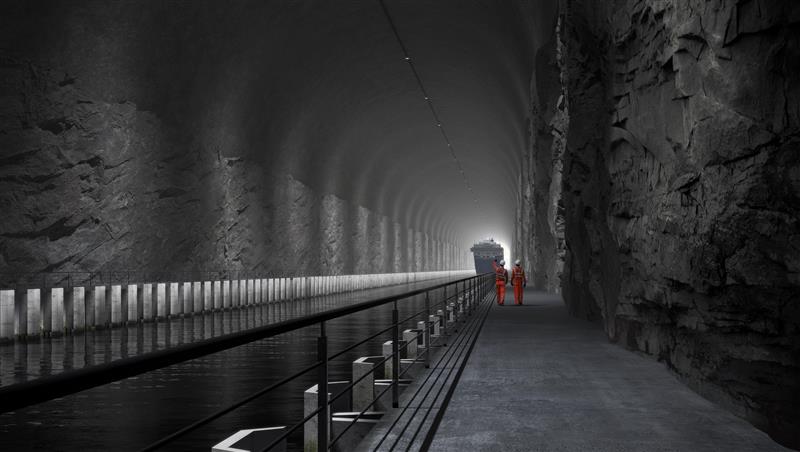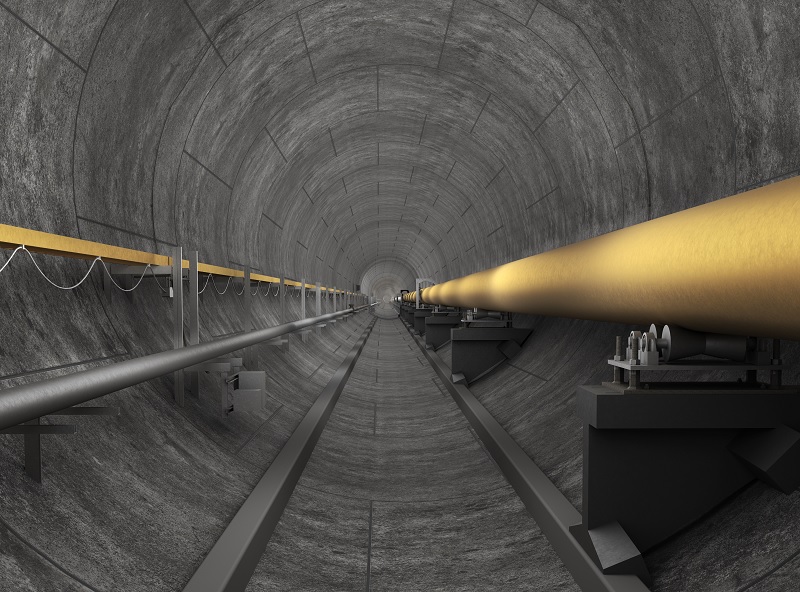Tunnel projects dot the landscape
 An artist’s conception of the Stad Ship Tunnel, courtesy Kystverket/Norwegian Coastal Administration/Link Arkitektu.
An artist’s conception of the Stad Ship Tunnel, courtesy Kystverket/Norwegian Coastal Administration/Link Arkitektu.
World’s first full-scale tunnel for ships slated for construction
April 16, 2025
It seems like tunnels are on the minds of many people—they’re thought of and being built around the globe.
In Las Vegas, crews are constructing a 68-mile tunnel system called the Vegas Loop to transport passengers in electric vehicles around the Las Vegas urban core.
Under construction is an extension of the Chesapeake Bay Bridge Tunnel in Virginia that will one day move additional cars under the bay. Construction is expected to be completed by 2028.
There’s even talk about a tunnel linking Africa to Europe across the Mediterranean. The proposed undersea tunnel, potentially connecting Spain and Morocco under the Strait of Gibraltar, aims to use a high-speed rail line to link the two continents, with potential completion by 2030.
Maritime tunnels work and help people
Understanding construction of maritime tunnels that enhance environmental safeguards is a practical solution to alleviating congestion on busy waterways, the Norwegian Coastal Administration (NCA) is constructing the world’s first full-scale tunnel for ships.
“The Norwegian Coastal Administration is responsible for all digital and physical infrastructure along the Norwegian coast, which is the world’s second longest after Canada,” said Einar Vik Arset, NCA director general.
“We are also the project owner for Stad Skipstunnel (in English, the Stad Ship Tunnel). Stad Skipstunnel is primarily a sea-safety measure. Now this will be ‘smooth sailing’ through Stad Skipstunnel, and I think it will be an experience in itself,” Arset added.
NCA had been exploring the tunnel option since the 1990s.
In 2021, the Norwegian Parliament approved the project. The NCA issued bids for construction in January 2025
Much like Michigan’s Great Lakes Tunnel that Enbridge plans to construct deep under the lakebed of the Straits, the Stad Ship Tunnel is necessary on multiple levels, according to the NCA.
Officials cite enhancing the safety and efficiency of transportation, environmental safeguards and economic development.
 An artist’s conception of the Stad Ship Tunnel, courtesy Kystverket/Norwegian Coastal Administration/Link Arkitektu.
An artist’s conception of the Stad Ship Tunnel, courtesy Kystverket/Norwegian Coastal Administration/Link Arkitektu.
Designed to accommodate cargo and passenger vessels, the Stad Ship Tunnel—1.7 kilometers long, 50 metres high and 36 metres wide—will eliminate the need for vessels to navigate the rough waters synonymous with the Stad peninsula, which extends into the Norwegian Sea.
Designed by Snøhetta, the tunnel’s entrance will feature rough-hewn rock walls, walkways and a road bridge that blends with the area’s natural landscape. It also will incorporate scenic viewpoints, according to NCA.
“As with the Great Lakes Tunnel project, from my understanding the Stad Ship Tunnel is designed to provide a practical, viable solution that will deliver safety, environmental and practical benefits to the region,” said Paul Meneghini, Enbridge’s manager, community engagement.
“The Stad Ship Tunnel is a significant undertaking, and we are eager to watch it progress.”
Great Lakes Tunnel project made possible by technology
Placed deep under the lakebed of the Straits, the Great Lakes Tunnel will house a replacement section of Line 5, thereby protecting the Great Lakes and the people who use its precious waters.
“We’ve hired one of the best teams in the world to build the Great Lakes Tunnel project,” continued Meneghini.
“What makes the tunnel possible is the proven technology, especially the Tunnel Boring Machine that can dig while laying a new tunnel. It’s safe and amazing technology that allows these engineering feats to be built around the world.”
 This is an artist’s conception of the tunnel under the Straits of Mackinac.
This is an artist’s conception of the tunnel under the Straits of Mackinac.
Enbridge is planning a May 7 grand re-opening of its Great Lakes Tunnel Information Center in St. Ignace, where the public can get a closeup view of a tunnel boring machine working model.
“When they visit the Center, folks will be able to see firsthand how the Great Lakes Tunnel project offers a practical solution. The Tunnel will keep energy flowing to the people who need it, while keeping energy costs down, and protecting the environment. It’s a win-win in many ways,” said Meneghini.
NCA plans to begin construction of its one-mile-long tunnel in late 2025. It anticipates construction will be completed in 2030. To view a video, click here.









